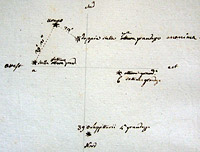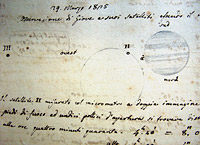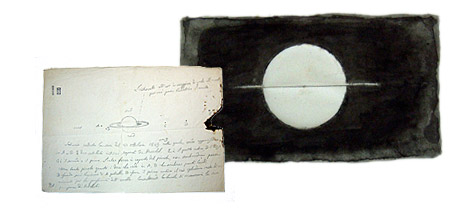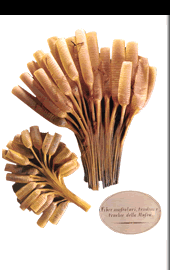Astronomical Observations
Amici dedicated most of his astronomical observations to double stars since they constituted an excellent test for his telescopes, but he also pointed his objectives to the sun as well, to measure its equatorial and polar diameters, to observe eclipses and sunspots, and to Mars, Jupiter and Saturn and their satellites, and to comets. He did not disdain meteors or falling stars either; but he left little published material about this.
Among his manuscripts there are nine files full of measurements of double and triple stars for the years 1813-1815, 1817, 1823-1826 and 1828. Amici carried out his observations from his house, Villa della Madonnina, located in open countryside west of Modena, and at that time he preferred to use a Newtonian telescope, with 8 feet of focal distance and an 11 inch aperture which he had constructed and on which he had mounted his micrometer with a bisected lens.
 He sent a letter in 1823 about the difficulties in measuring double stars to Baron von Zach, who translated it into French and published it under the title Sur la mesure des étoiles doubles in vol. VIII of the “Correspondance astronomique” (download pdf).
He sent a letter in 1823 about the difficulties in measuring double stars to Baron von Zach, who translated it into French and published it under the title Sur la mesure des étoiles doubles in vol. VIII of the “Correspondance astronomique” (download pdf).
J. F. W. Herschel stopped twice in Modena as he travelled through Italy in 1824. In those years Herschel was actively working on double and triple stars together with James South. On 26 September Amici wrote his friend Giovanni Plana, Royal Astronomer in Turin:
Mr. Herschel was so good as to come by to see me both in his first trip through and on his return trip about a month ago. [...] It appears that Mr. Herschel was very satisfied with my instruments. He brings with him to London one of my distance measurers and as soon as possible I will send him one of the large micrometers to apply to a seven-foot achromatic telescope which he wishes to use to measure double stars.
We have agreed to communicate our observations of these stars to each other, and he has in the meantime left me the manuscript catalogue of the observations already carried out with Mr. South (cf. A. Meschiari, Corrispondenza di Giovanni Battista Amici con Giovanni Plana, “Nuncius”, 1-2000).
Few other notes about measuring double stars bear the dates of 11 August 1839 and 3 June 1849. These last measurements were done from his new home, Villa di Noce, in Tavarnelle Val di Pesa, on the hills between Florence and Siena, using an achromatic telescope he had constructed, with 9 feet 8 inches of focal distance and a 9-inch objective aperture. Other measurements are entered in September-October 1849, in October 1851 and in September 1857.
 From his handwritten notes we know that Amici observed the eclipses of 8 July 1842, when he took “photogenic images by applying a camera oscura to a large telescope”, and of 6 May 1845, 9 October 1847, 28 July 1851 and 18 July 1860. Some drawings of sunspots are dated March 1825. He measured the equatorial and polar diameters of the sun in the years 1820-1822 and again on 17 September 1848 and in September 1857 at the Villa di Noce, with the 9-inch aperture refractor.
From his handwritten notes we know that Amici observed the eclipses of 8 July 1842, when he took “photogenic images by applying a camera oscura to a large telescope”, and of 6 May 1845, 9 October 1847, 28 July 1851 and 18 July 1860. Some drawings of sunspots are dated March 1825. He measured the equatorial and polar diameters of the sun in the years 1820-1822 and again on 17 September 1848 and in September 1857 at the Villa di Noce, with the 9-inch aperture refractor.
On 4 August 1813 he observed Mars at 10 PM, Jupiter from 1813 to 1815, and its satellites during daylight from 1823 and 1825. On 30 May 1825 he wrote to Baron von Zach, who published his observations, written in Italian, in the “Correspondance astronomique” (vol. XII-1825) with the French title Observations des satellites de Jupiter en plein jour (download pdf).
He carried out observations on Saturn’s rings in 1821, 1825 and 1838. On 8 May 1859 he registered the occultation of this planet. He saw its satellites on the evening (8p.m.) of 21 August 1812 with the Newtonian telescope with an 8 foot focal length and 11 inch aperture, and the evening (9p.m.) of 22 October 1849.

Other handwritten notes report on comets. On 21 January 1821 he observed the comet of Pons which had been discovered in Marlia; another comet of Pons on 3 October 1824; Biela’s comet on 31 October 1832; Halley’s comet in September-October 1835; the comet of March 1843; Peterson’s comet on 12 July 1850; the comet of June 1853 and that of March 1854 for which he reported to the press about the approximate parabolic elements (cf. Elementi parabolici approssimati della cometa, download pdf).
The Astronomie populaire by François Arago (vol. 14 of the Oeuvres complètes, 2nd ed., vol. II, published posthumously, Morgand, Paris 1865) contains some of the information from Amici about observations of comets:
Parme, Bologne, etc., 28 février [large comet of 1843]. - La comète, aperçue d’abord par des curieux en plein Soleil, et considérée comme un météore, était à l’heure de midi, d’après une observation de M. Amici fils, de 1° 23' à l’est du centre du Soleil. M. Amici dit seulement que l’astre était fumeux vers l’est. Les observateurs de Parme assurent qu’en se plaçant derrière un pan de mur cachant le Soleil, on voyait une queue de 4 à 5 degrés de long [p. 318].
1835. Dans son plus grand éclat, vers le milieu d’octobre, à la simple vue, le noyau de la comète de Halley nous paraissait pouvoir être assimilé aux étoiles rougeâtres de première grandeur, telles que α du Scorpion, α d’Orion ou α du Taureau, si même il ne les surpassait en intensité. M. Amici nous écrivait de Florence: “Le 12 octobre, la comète à l’oil nu me semble plus brillante que les étoiles de la Grande Ourse”. Les étoiles de la Grande Ourse sont de seconde grandeur, et le 12 octobre n’était pas la date du plus grand éclat de la comète [p. 372].
And in Chapitre XXIII. La matière dont se compose la tête d’une comète subit-elle des changements physiques dans des temps de courte durée? [The subject is once again observations on Halley’s comet in its reappearance of 1835], p. 395-396:
Suivant une lettre que j’ai reçue d’Irlande, M. Cooper aperçut aussi des secteurs lumineux, ou aigrettes, dans son Observatoire de Markree, le 19 octobre[...]
J’ajouterai que, d’après ce que me manda M. Amici, directeur de l’Observatoire de Florence, cet astronome vit, le 13 octobre, six rayons lumineux très-vifs partant en divergeant du noyau, et qui s’étendaient à des distances inégales dans la nébulosité. Les jours suivants, ces rayons avaient disparu.
Les phénomènes singuliers que nous venons de décrire ont été l’objet d’une très-savante dissertation publiée par Bessel, de l’Observatoire de Koenigsberg. En discutant ses propres observations, l’illustre astronome arrive à cette conséquence: que l’axe du secteur lumineux s’écartait beaucoup momentanément, de part et d’autre, de la direction du Soleil, mais qu’il revenait toujours à cette direction pour passer de l’autre côté. Le mouvement oscillatoire, suivant son évaluation, serait de 4'.6, et son amplitude se montrerait à 60°.
La juste déférence que tout astronome ne peut manquer de montrer pour les travaux de Bessel ne doit pas m’empêcher de faire remarquer que le 13 octobre, jour où l’observateur de Koenigsberg ne voyait aucun indice du secteur lumineux, M. Amici, à Florence, en apercevait distinctement 5.
Giovanni Battista Donati observed the comet at the beginning of June 1858 with the large Amici refractor - with an aperture of 0.28 m and a focal distance of 5.2 m, and using magnifications from 100 to 600 times - in use at the Royal Observatory of Florence, and when he published Sulle apparenze fisiche della gran cometa del 1858 < On the physical appearances of the great comet of 1858 > (“Il Nuovo Cimento”, vol. VIII-1858), he added that
the appearances which I am describing were noted, more or less in the same way, by Prof. Amici who made his observations from his Villa with a 0.24m-aperture refractor furnished with a double image ocular micrometer, determining the various measures that I will list here below. [...]
On 4 [June] Prof. Amici also saw the same obscure spot which on the 6th moved towards the front part of the aureole: and at that point it seemed to him that the spot became the starting point of a weak, dark line that extended in a circle all around the nucleus and divided its first aureole.
Amici also observed falling stars, in some cases with opera glasses, on 10 August of 1839, 1841, 1842 and 1847, registering their related constellation, time, direction of movement and size. He was also present at the appearance of a meteor on 26 August 1850.
Among his papers there are as well many which contain registrations of meteorological, barometric, thermometric, hygrometric and anemometric data, with indications of the atmospheric state and, in the 1840s, of the magnetic declination. There are entries for the years 1823-1827, 1834, 1835-1837, 1840-1844 and 1855. The ones carried out at the Observatory of the Museum of Florence from December 1841 to 1843 are complete and well ordered. Amici also observed the aurora borealis on 18 February and 12 November of 1837.
